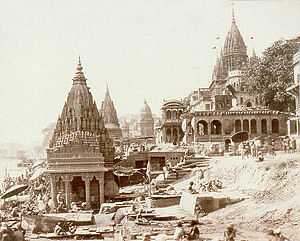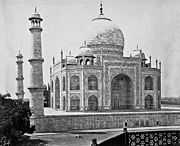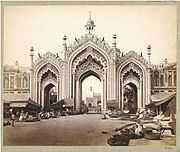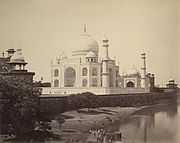Samuel Bourne

Samuel Bourne (30 October 1834 – 24 April 1912)[1] was a British photographer known for his prolific seven years' work in India, from 1863 to 1870.[2] Together with Charles Shepherd, he set up Bourne & Shepherd first in Shimla in 1863 and later in Kolkata (Calcutta); the company still exists today.[3][4]
Biography
Samuel Bourne was born into an old farming family, at Arbour Farm, Mucklestone, Shropshire in 1834. After being educated by a clergyman near Fairburn, he secured a job with Moore and Robinson's Bank, Nottingham in 1855. His amateur photographic activities started at about this time and he quickly became an accomplished landscape photographer, soon lecturing on photography and contributing technical articles to several photographic journals.
In 1858, Bourne made a photographic tour of the Lake District, and in 1859, displayed photographs at the Nottingham Photographic Society's annual exhibition. The following year, his photographs were also shown in London, at the London International Exhibition of 1862. This reception he received motivated him to give up his position at the bank, and set sail for India to work as a professional photographer; arriving in Calcutta early in 1863.

He initially set up in partnership with an already established Calcutta photographer, William Howard. They moved up to Simla, where they established a new studio ‘Howard & Bourne’, to be joined in 1864 by Charles Shepherd, to form ‘Howard, Bourne & Shepherd’. By 1866, after the departure of Howard, it became ‘Bourne & Shepherd’, which became the premier photographic studio in India, and is still trading in Calcutta today; perhaps the world’s oldest photographic business.[citation needed] Charles Shepherd evidently remained in Simla, to carry out the commercial and portrait studio work, and to supervise the printing and marketing of Bourne’s landscape and architectural studies, whilst Bourne was away travelling around the sub-continent.
Bourne spent six extremely productive years in India, and by the time he returned to England in January 1871, he had made approximately 2,200 fine images of the landscape and architecture of India and the Himalayas. Working primarily with a 10x12 inch plate camera, and using the complicated and laborious Wet Plate Collodion process, the impressive body of work he produced was always of superb technical quality and often of artistic brilliance.[citation needed] His ability to create superb photographs whilst travelling in the remotest areas of the Himalayas and working under the most exacting physical conditions, places him firmly amongst the very finest of nineteenth century travel photographers.[citation needed]
On 29 July 1863, he left Simla on the first of his three major Himalayan photographic expeditions. With a retinue of some 30 porters to carry his equipment, he travelled across the Simla Hills to Chini, in the Valley of the Sutlej River, 160 miles north-east of Simla, and spent some time photographing in the Chini-Sutlej River area, before heading up to the borders of Spiti, and returning to Simla on 12 October 1863, with 147 fine negatives.
In the following year, Bourne set out on another major trip, this time a nine-month trip to Kashmir. Leaving Lahore on 17 March, he journeyed north-east to Kangra and from there, via Byjnath, Holta, Dharmsala and Dalhousie, to Chamba. From there, he went on to Kashmir, arriving on the borders on 8 June; by the middle of the month had reached the Chenab Valley. The following weeks were spent photographing the scenery of Kashmir before proceeding to Srinagar, where he stopped for some weeks, sight seeing and photographing before continuing his journey on 15 September. The return journey took in the Sind Valley, Baramula, Murree, Delhi and Cawnpore (now Kanpur) before arriving in Lucknow on Christmas Eve 1864.
Bourne's third and last major trip was perhaps his most ambitious; consisting of a six-month journey in the Himalayas with the goal of reaching and photographing the source of the Ganges. He left Simla on 3 July 1866, in the company of Dr. G.R. Playfair (brother of the famous English politician Dr. Lyon Playfair), and travelled with him through Kulu and Lahaul, over the Kunzum Pass into the Spiti valley, where they later parted company. Bourne then continued on alone (except for his forty porters!); over the Manirung Pass, where he took spectacular views of the 18,600 foot high pass; which held the record for the highest altitude photographs that had yet been taken for twenty years.[citation needed] Thence, down to the junction of the Spiti and Sutlej Rivers and on to Sungnam and the Buspa Valley. He then climbed up over the Neela Pass, and down into the Upper Ganges Valley, where he journeyed on up to the Gangotri Glacier. There he went on to photograph one of the prime sources of the Ganges, as it issued from the mouth of the glacial ice cave at Gaumukh. His return journey took in Agra, Mussoorie, Roorkee, Meerut and Naini Tal, and he arrived back in Simla, again in time for Christmas! He wrote extensively about his travels in the Himalayas (one of the very few photographers in India to do so), in a long series of letters, which appeared in The British Journal of Photography, between 1863 and 1870.
The studio business prospered, and in 1866, they opened a second branch in Calcutta, where they ran a portrait studio, and their work was widely retailed throughout the subcontinent by agents and in Britain through wholesale distributors.[5] In 1867 he went briefly back to England, in order to marry Mary Tolley, daughter of a wealthy Nottingham businessman; and they both returned to India again later that year, where he continued to travel around the country, producing some 500 more fine images.[citation needed] He departed Bombay for England permanently in November 1870. His work as travelling landscape and architectural photographer for Bourne & Shepherd studios was taken over by Colin Murray, who continued taking fine images of India, in a very similar style, and later went on to take over the management of the business.[citation needed]
Some time shortly after his return to England, he sold off his interests in Bourne and Shepherd studios, and from then on, had nothing more to do with commercial photography; however his archive of some 2,200 glass plate negatives remained with the studio, and were constantly re-printed and sold over the following 140 years, until their eventual destruction in a Calcutta fire on 6 February 1991.
Back in England
Bourne settled back in Nottingham, where he founded a cotton-doubling business, in partnership with his brother-in-law J.B. Tolley. The business prospered, and Bourne become a local magistrate. Although continuing to photograph as a relaxation, and belonging to the local Photographic Society, much of his creative energy from this time onwards was devoted to water-colour painting. He died in Nottingham on 24 April 1912.
Bourne is justly regarded as one of the finest landscape and travel photographers of 19th century India; combining a fine eye for composition with high technical expertise.[citation needed]
Gallery
-

Photograph of the Taj Mahal. Samuel Bourne, 1860s.
-
Photograph of the Taj Mahal from the river. Samuel Bourne, 1860.
-

Gateway to the Hooseinabad Bazaar in Lucknow, 1863-1866 V&A Museum no. 7-1972
Notes
- ↑ Photographs of India. circa 1862 - circa 1872 - Samuel Bourne Biography Cambridge University Library.
- ↑ Early Photographs and Early Photographers: A Survey in Dictionary Form, by Oliver Mathews. Edition: illustrated. Published by Reedminster Publications, 1973. ISBN 0-85945-001-5. Page 37.
- ↑ Bourne & Shepherd, Esplanade , Kolkata, India - Image Flickr
- ↑ Photography bastion in a shambles Indian Express, 19 July 2007.
- ↑ Bourne & Shepherd (floruit 1865-) National Portrait Gallery.
References
- Arthur Ollmann, Samuel Bourne: Images of India, a profound book on Bourne and his photography. ISBN 0-933286-36-8
- Bourne & Shepherd (floruit 1865-) National Portrait Gallery
- Hugh Rayner, ed., Photographic Journeys in the Himalayas by Samuel Bourne. The complete texts of four series of letters by Samuel Bourne to the British Journal of Photography, originally published between 1 July 1863 and 1 April 1870. A newly revised and enlarged edition, with additional appendices, including a Catalogue of almost the entire body of some 2,200 photographs, taken by Bourne in India, together with the text of two of his lectures: On Some of the Requisites Necessary for the Production of a Good Photograph from 1860, and The Original Fothergill Process, first published in 1862. It includes previously unidentified photographs of him during his travels, an enlarged bibliography and other new material, including fragments of Samuel Bourne’s own poetry. 3rd (revised & enlarged) edition 2009. Published by Pagoda Tree Press, Bath, England. ISBN 978-1-904289-64-7
- Lenman, Robin (ed.) 2005 The Oxford Companion to the Photograph (Oxford: Oxford University Press) [Includes a short biography on Bourne & Shepherd.]
- The Imperial Gaze. The Photographs of Samuel Bourne (1863–1870). 28-page catalogue of exhibition, with 17 images essay, notes and bibliography. The Alkazi Collection of Photography and Sepia (2004).
External links
| Wikimedia Commons has media related to Samuel Bourne. |
- An extended biography, and a catalogue of Samuel Bourne images
- A History of Photography, by Robert Leggat: BOURNE, Samuel at www.rleggat.com
- George Eastman House Samuel Bourne Series at www.geh.org
- Chronology of Samuel Bourne life
|

